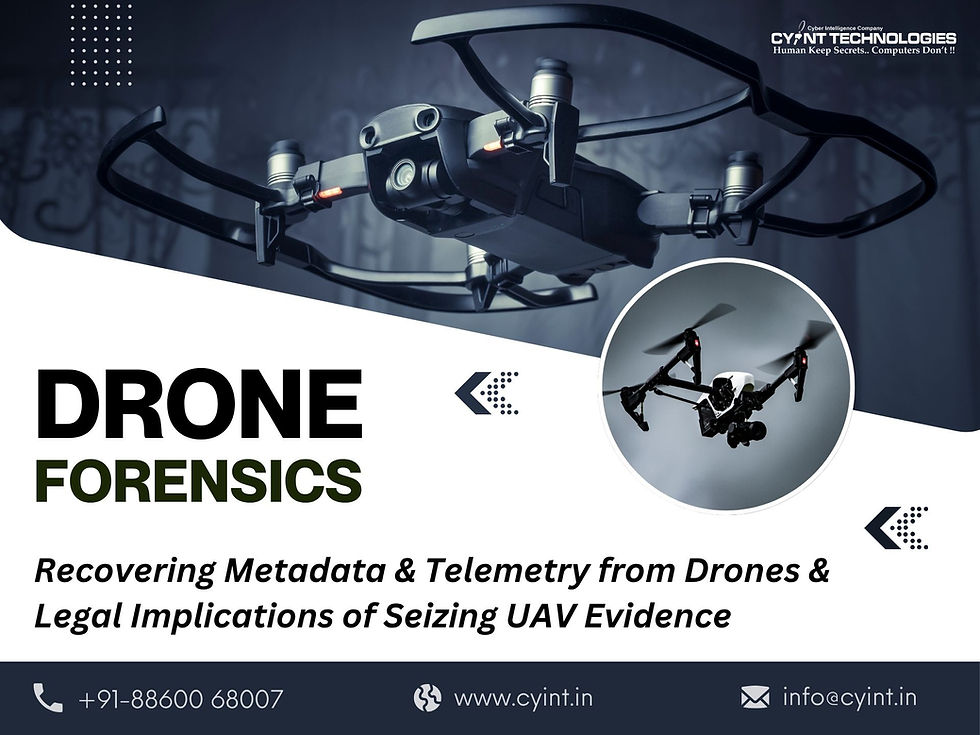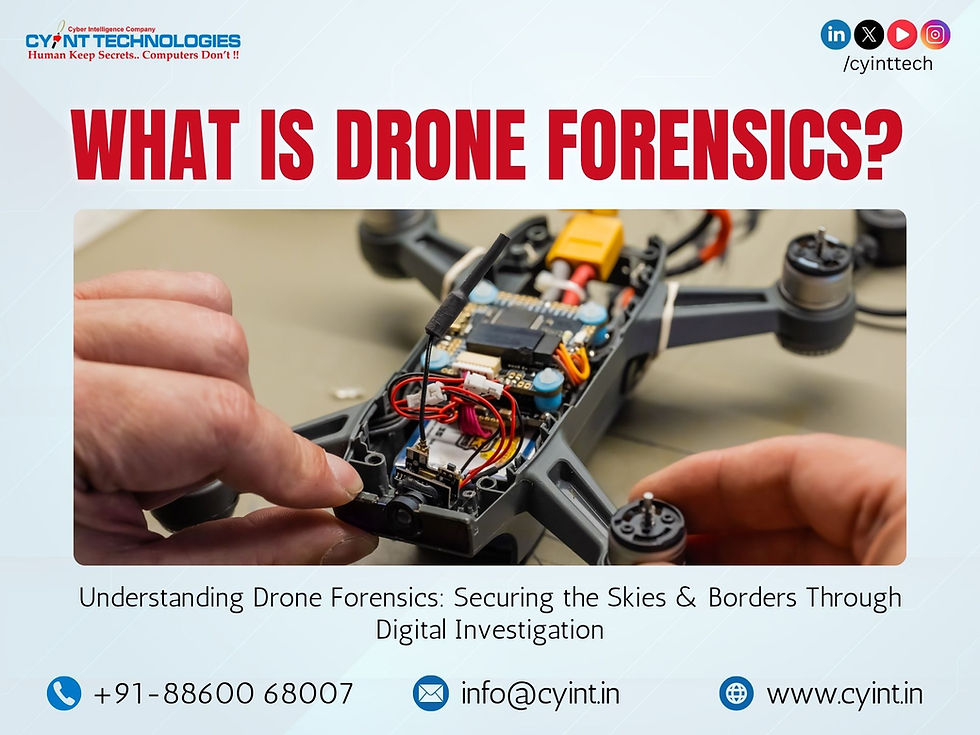THE SILVER LINING: A GUIDE TOWARDS CLOUD FORENSICS
- Yagyak Dutta
- Aug 16, 2023
- 4 min read
Updated: Aug 17, 2023

In the ever-fickle landscape of technology cloud has proven itself as a force to be reckoned with because of its ability to provide on-demand computing services and efficient data storage the cloud has revolutionized the way organizations operate however along with the benefits of cloud computing come new challenges particularly in the realm of digital investigations cloud forensics the application of forensic techniques in cloud environments has become essential in uncovering evidence and solving cybercrimes in this comprehensive guide we will deep-dive into the depths of cloud forensics exploring its methodologies tools and the unique challenges it poses.
THE BASICS: CLOUD and FORENSICS
Understanding Cloud Computing and Digital Forensics
Cloud computing has transformed the way it services are accessed and managed. It allows for the storage synchronization and sharing of data across devices offering unparalleled convenience and scalability. Simultaneously the rise in computer-related crimes has necessitated the use of Digital Forensics to investigate and prosecute offenders. Digital Forensics involves the Identification, Examination, Collection and Analysis of data while preserving its integrity and maintaining a strict chain of custody. Cloud Forensics can be considered as a subset of Network Forensics which focuses on investigating criminal activities that involve cloud computing.
The Three dimensions of Cloud Forensics
Cloud forensics encompasses three key dimension - the technical dimension, the organizational dimension and the chain of dependencies. The technical dimension involves the use of tools and procedures to carry out forensic processes in cloud computing environments. This includes data collection, elastic/static/live forensics, evidence segregation and investigations in virtualized environments. The organizational dimension emphasizes the need for collaboration and coordination between cloud consumers and cloud service providers (CSPs) as well as the establishment of dedicated forensic teams. The Chain of dependencies highlights the interconnection of CSPs and the challenges that arise from complex relationships within the cloud environment.

TAXONOMIC TOOLS AND TUNED TECHNIQUES FOR CLOUD FORENSICS
Evidence Acquisition and Analysis
In cloud forensics the acquisition and analysis of evidence are of utmost importance. Forensic investigators must obtain network packets for traffic analysis. Access workload memory and disk volumes and collect logs and event data from both workloads and the cloud environment. The challenge lies in the sheer volume of data generated, necessitating efficient tools and techniques to process and analyse the evidence. While cloud-specific forensic tools are still emerging, investigators rely on established methodologies, such as accessing the guest OS layer for data collection, Utilizing tools like FORST and F-response for API logs, virtual disk collection, remote mounting/acquisition of Amazon S3, Rackspace cloud files, HP public cloud, Openstack cloud files and Windows Azure Storage as well as performing Metadata, Timeline and Connections based analysis using specialized tools like the UFED Cloud Analyzer and Magnet Axiom cyber.
Automation and Continuous monitoring
Automation has become a crucial focus in cloud forensics and incident response. Continuous monitoring of the cloud environment is essential to detect suspicious activity or malicious code promptly. Cloud-native tools like AWS config can be employed to assess resources for security conditions and locate and tag suspect assets. Automated processes can be initiated to acquire evidence, perform remediation actions such as quarantine or termination of workloads and ensure proper monitoring along with chain of custody through logs and audit trails. By leveraging automation, investigators can improve the efficiency and effectiveness of their forensic investigations.
RAIN OF CHALLENGES IN THE CLOUD
Legal and Jurisdictional complexities
Cloud forensics presents unique legal and jurisdictional challenges. Multi-jurisdictional and multi-tenancy issues can complicate investigations as data may be stored in different regions with varying regulations. It is crucial to ensure that investigations adhere to local laws and regulations while preserving privacy, confidentiality, integrity, and availability. Service level agreements (SLAs) between cloud consumers and CSPs need to address the provision of forensic investigation services, clearly define roles and responsibilities, and uphold legal and privacy requirements. Collaboration between law enforcement agencies third-party auditors and academia is also vital to ensure effective forensic activities in the cloud.
Scalability and Data volume
The scalability of cloud computing brings both advantages and challenges to cloud forensics. While cloud storage offers expanded capacity, the sheer volume of data generated can overwhelm investigators. Traditional forensic techniques may struggle to handle the vast amounts of data necessitating the development of innovative methods for data processing and analysis. Investigators must adapt their methodologies and tools to keep up with the scalability of cloud environments.
Collaboration and coordination
The interconnected nature of cloud environments requires close collaboration and coordination between cloud consumers, CSPs and other parties involved the chain of dependencies within the cloud ecosystem which can complicate investigations and hinder effective communication. Establishing organizational norms, enforcing legally binding SLAs and fostering strong relationships between stakeholders are crucial to ensure smooth collaboration and coordination during forensic investigations.
FROM EXCEPTION TO EVIDENCE: FUTURE OF CLOUD FORENSICS
As cloud computing continues to evolve so too will the field of cloud forensics. Researchers and practitioners are actively working to develop specialized tools and methodologies to address the unique challenges posed by cloud environments. Cloud service providers are increasingly recognizing the importance of integrating forensic capabilities into their offerings allowing for better investigation and analysis of cloud-related incidents furthermore, advancements in automation machine learning and artificial intelligence hold promise for improving the efficiency and accuracy of cloud forensics. With ongoing development and collaboration, cloud forensics will continue to strengthen digital investigations in the ever-expanding realm of cloud computing.
Cloud forensics is a vital discipline in the fight against cybercrime and the investigation of criminal activities in cloud environments as the reliance on cloud computing grows so does the need for skilled professionals who can navigate the complexities of cloud forensics by understanding the basics of cloud computing, the tools and techniques used in cloud forensics, the challenges and considerations involved, investigators can effectively uncover digital evidence and bring cybercriminals to justice. With continual advancements and collaboration cloud forensics will play an increasingly significant role in the future of digital investigations. Stay informed adapt to new technologies and embrace the ever-changing landscape of cloud forensics to stay one step ahead in the fight against cybercrime.
Sign up for the Newsletter and stay up to date with the emerging trends in the vast domain of Cloud Forensics.
Yagyak Dutta
Digital Forensic Analyst - DFaaS (DF)
Cyint Technologies






